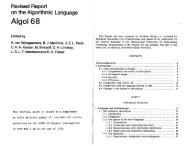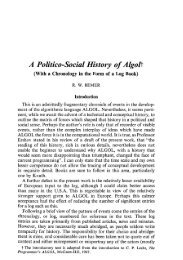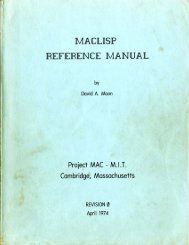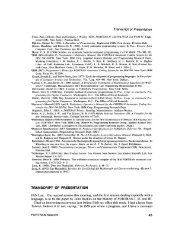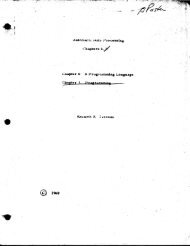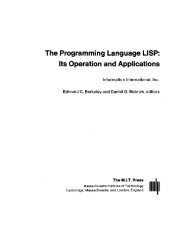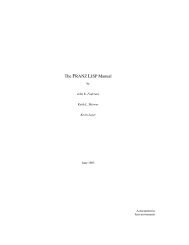- Page 1:
Artificial Intelli~cnce GroupJ. McC
- Page 5:
Contents1 . Introduction ..........
- Page 9 and 10:
2. Recursive Functions of Symbolic
- Page 12 and 13:
expression was, defined, the meanin
- Page 14:
Let f be an expression that stands
- Page 17 and 18:
There is a twofold reason for depar
- Page 19 and 20:
2, eq - 4eq[x;y] is defined if and
- Page 21 and 22:
2. sub~t[x;~;z]This function gives
- Page 23 and 24:
z;eq[caar[x];z]sub2[x;~];~((u1,vi)
- Page 25 and 26:
The S-functLon apply is defined byI
- Page 27 and 28:
The list p - could be eliminated, a
- Page 29 and 30:
3. LISP PrimerThe features of LISP
- Page 31 and 32:
The answer ( ((x A) B) (X A) ) will
- Page 33 and 34:
one introducing it into the consequ
- Page 35 and 36:
h,~~,pand)Y,SP5a. Rule4>: If j,++h,
- Page 37 and 38:
to one of the 10 rules. The formula
- Page 39 and 40:
(~111(LAMBDA( ~1 A2 A C) (COND ((NU
- Page 41 and 42:
This causes the functions mentioned
- Page 43 and 44:
4. The LISP Programming SystemIn th
- Page 45 and 46:
Example 3:The following example, on
- Page 47 and 48:
In either case, if a machine-langua
- Page 49 and 50:
Note that the argument x starts wit
- Page 51 and 52:
sion whose first element may be LAM
- Page 53 and 54:
5 = (atomic function, arguments): C
- Page 55 and 56:
- PROG is a special form described
- Page 57 and 58:
When a list beginning with GO is en
- Page 59 and 60:
Since the program feature will be u
- Page 61 and 62:
and goes ahead after printing out(f
- Page 63 and 64:
eturn[fn[a]In terms of the M-type n
- Page 65 and 66: ( , SXD, G0011,4),LD&,G0002)( ,C;LA
- Page 67 and 68: push-down(MAPLIST,BSS, 0)( ,SXD,GOO
- Page 69 and 70: Ls.( ,O,U( ,STO,G0015)( , LXD, $FRE
- Page 71 and 72: Running a LISP ProgramIn this secti
- Page 73 and 74: SET :Note:FLX*:CRD*:FIN:This card w
- Page 75 and 76: Sense switches used:SWITCH NUMBERUS
- Page 77 and 78: The Flexowriter Sys tem (for M.1.T.
- Page 79 and 80: indicates carriage returnindicates
- Page 81 and 82: TEN-ModeThere are ten buffers of co
- Page 83 and 84: ErrorsTyping errors may be erased b
- Page 85 and 86: (from the tab type-in) will be proc
- Page 87 and 88: answerTENCAR ((A@) 0- LINE NUMBER M
- Page 89 and 90: 6. List StructuresMuch of the follo
- Page 91 and 92: y either the list structure of Fig.
- Page 93 and 94: which is represented asFirst we con
- Page 95 and 96: the location of the association lis
- Page 97 and 98: and the decrement of the TXL instru
- Page 99 and 100: the 2's (8's) complement of an octa
- Page 101 and 102: 25207 052567 05257025210 000000 000
- Page 103: garbage collector does a linear swe
- Page 106 and 107: The function collapse, is defined a
- Page 108 and 109: THE TIME IS NOW 2/16 1139.7FUNCTION
- Page 110 and 111: DEFINE( ( (RVRSE, (LAMBDA, (L ) JCO
- Page 113 and 114: 8. Error Indications Given by LISPB
- Page 115: Errors due to computer inadequacies
- Page 119 and 120: 9. Functions Available in LISPIn th
- Page 121 and 122: s[x;y] : machine languageThe value
- Page 123 and 124: eval[e;b] - : machine languageThe r
- Page 125 and 126: Defining Functions:The argument of
- Page 127 and 128: MORE]nconc[x;y]: machine languageTh
- Page 129 and 130: evaluated functions. - map is used
- Page 131 and 132: -ins t [x;y; z]: machine languageHe
- Page 133 and 134: prog[prin2[d~rinl[~];The function p
- Page 135 and 136: puncha[x] : machine languageThe fun
- Page 137 and 138: 9.2 Special Formsquote : machine la
- Page 139 and 140: function[ f ] : machine language; s
- Page 141 and 142: desc[cdr[x];cdr[y]-desc[x;y] : mach
- Page 143 and 144: eturn[^]intv[x] : machine language;
- Page 145 and 146: The program for compsrch has the pr
- Page 147 and 148: NIL;T+The value of - cpl is the loc
- Page 149 and 150: --- ~reaterlp; q] : machine languag
- Page 151 and 152: matrixmultiply[x;y] : machine langu
- Page 153 and 154: 9.5 Alphabetic Index to FunctionsFu
- Page 155 and 156: Function Page .mapcon .............
- Page 157 and 158: GENERAL INDEXActive register, 96APP
- Page 159 and 160: GENERAL INDEXFunctions, 3alphabetic
- Page 161 and 162: GENERAL INDEXPropositionalcalculus;



